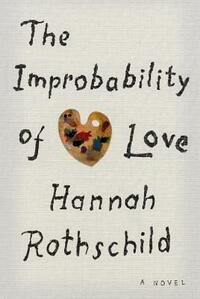You need to sign in or sign up before continuing.
Take a photo of a barcode or cover
Wonderful, amazing book!! Thankfully I was able to read an advanced copy of this delightful book about a talented young chef, an influential family in the art world and a presumed lost masterpiece by Watteau. A fun twist is the voice of the painting is included which adds a layer of unexpected depth and humor to the story. There is a great plot twist or two that make this book hard to put down and turns this lovely novel into a bit of a mystery! I heightened recommend this book!
lighthearted
slow-paced
I really, really enjoyed this. The Improbability of Love came to my attention as a fairly improbable (lol) inclusion on the Bailey’s Prize shortlist.
The title comes from the name of a painting which is at the centre of the story, which opens with its auction to a variety of wealthy and ridiculous people. However, the narrative really kicks off some six months earlier when the broke and heart-broken Annie finds it in a junk shop as a gift for a potential love interest. This sends her suddenly into the art world as it begins to appear that this painting may well have a rich and dark history.
Rothschild just brilliantly draws sympathetic, and not so sympathetic characters, from Annie and her alcoholic mother, to the truly ridiculous movers and shakers in the art world. The plot also moves really well between crazy goings-on in London to exploring some of the truly dark periods of history, and the lengths that people can go to protect themselves. A particularly great technique that Rothschild uses is having the painting itself narrate certain passages, giving a really great insight into the historical importance of art.
The Improbability of Love is a really fun read, which has made me want to visit an art gallery like tomorrow, and I’m so hoping it gets some kind of BBC mini-series adaptation because the novel is just crying out for it.
The title comes from the name of a painting which is at the centre of the story, which opens with its auction to a variety of wealthy and ridiculous people. However, the narrative really kicks off some six months earlier when the broke and heart-broken Annie finds it in a junk shop as a gift for a potential love interest. This sends her suddenly into the art world as it begins to appear that this painting may well have a rich and dark history.
Rothschild just brilliantly draws sympathetic, and not so sympathetic characters, from Annie and her alcoholic mother, to the truly ridiculous movers and shakers in the art world. The plot also moves really well between crazy goings-on in London to exploring some of the truly dark periods of history, and the lengths that people can go to protect themselves. A particularly great technique that Rothschild uses is having the painting itself narrate certain passages, giving a really great insight into the historical importance of art.
The Improbability of Love is a really fun read, which has made me want to visit an art gallery like tomorrow, and I’m so hoping it gets some kind of BBC mini-series adaptation because the novel is just crying out for it.
Reseña en español | Review in English
Prometía mucho... y decepcionó un poco. Desde que leí la trama de la novela quise leerlo -la historia de un cuadro del siglo XVIII, del pintor francés Antoine Watteau, perdido por 40 años y reencontrado en una tienda de segunda mano por una mujer inglesa, Annie, quién ha perdido el rumbo de su vida. Paralelamente, conocemos la historia de muchísimos personajes que se ven vinculados al cuadro: antiguos propietarios, gente que desea poseerlo aunque sea solo para salvar su reputación. La novela nos lleva a conocer el origen y la historia del cuadro, siendo incluso un instrumento interesante el hecho que, en un par de capítulos, la propia obra le hable al lector en primera persona. Sin embargo, creo que la debilidad de la historia es que hay muchísimos personajes, que si bien son interesantes, no creo que aporten en sí mucho a la historia del cuadro, cuyo título es, precisamente La improbabilidad del amor. Es decir que se siente como paja.
Siento que la premisa de la novela tenía muchísimo potencial y hubiera sido mucho más impactante sí el cuadro nos hubiera contado la historia: la propia, la de su creador y la de algunos personajes fundamentales. La trama es buena y tiene una suficiente dosis de thriller -los capítulos donde se descubre el secreto del imperio Winkleman son muy buenos- pero, vista como un todo, la novela tiene partes flojas en cuanto a producto literario.
Lo que sí es un punto a favor es que la novela nos brinda un retrato interesante del mundo del arte: cuadros, galerías, subastas, y un capítulo de la historia del cual, personalmente, tenía poco conocimiento: el saqueo de grandes obras de arte durante la Segunda Guerra Mundial. Otro tema que explora la novela que resultó interesante fue como se compara el arte de la pintura con el de la cocina -la forma en que Annie recrea grandes cenas barrocas o de la corte Louis XIV para ambientar la venta de cuadros es estupenda e incluso pudiera haberse explorado con más profundidad.
_____________________
The book sounded promising, but it disappointed me a little. Since I read the plot of the novel I wanted to read it badly: story of an eighteenth-century painting by the French painter Antoine Watteau, lost for 40 years and found in a second-hand shop by an English woman, Annie, who has lost her way of their life. In parallel, we get to know the story of many characters that are linked to the painting: former owners, people who want to own it even if only to save their reputation, lives or fortunes. The novel takes us through the origin and the history of the painting, and there was a very interesting element used on it, as in a couple of chapters, the painting itself to the reader. However, I think the weakness of the story is that there are many characters, and although they are interesting, I do not think they contribute much to the history of the painting, whose title is, precisely The improbability of love. That is to say, they add not much to the plot.
I feel that the premise of the novel had a lot of potential and it would have been much more impressive if the painting had told us the story: its own, that of its creator and that of some main characters. The plot is good and has a sufficient dose of thriller - the chapters where the secret of the Winkleman empire is discovered are very good -but, seen as a whole, the novel has loose parts.
One of the aspects which I did enjoy about the novel was the the description of the art world: galleries, museums and bidders. It was indeed great to hear again from Rembrandts and Rubens and well, Mr. Watteau. I also enjoyed reading about an episode in history which I know very little of: the robbery of great art works during WWII. Another interesting aspect was how the novel compares the art of painting to the art of cooking. The chapters where Annie recreates dinners from the barroque period or the court of Louis XIV were amazing and indeed, something which I believe could have been explored in more depth.
Prometía mucho... y decepcionó un poco. Desde que leí la trama de la novela quise leerlo -la historia de un cuadro del siglo XVIII, del pintor francés Antoine Watteau, perdido por 40 años y reencontrado en una tienda de segunda mano por una mujer inglesa, Annie, quién ha perdido el rumbo de su vida. Paralelamente, conocemos la historia de muchísimos personajes que se ven vinculados al cuadro: antiguos propietarios, gente que desea poseerlo aunque sea solo para salvar su reputación. La novela nos lleva a conocer el origen y la historia del cuadro, siendo incluso un instrumento interesante el hecho que, en un par de capítulos, la propia obra le hable al lector en primera persona. Sin embargo, creo que la debilidad de la historia es que hay muchísimos personajes, que si bien son interesantes, no creo que aporten en sí mucho a la historia del cuadro, cuyo título es, precisamente La improbabilidad del amor. Es decir que se siente como paja.
Siento que la premisa de la novela tenía muchísimo potencial y hubiera sido mucho más impactante sí el cuadro nos hubiera contado la historia: la propia, la de su creador y la de algunos personajes fundamentales. La trama es buena y tiene una suficiente dosis de thriller -los capítulos donde se descubre el secreto del imperio Winkleman son muy buenos- pero, vista como un todo, la novela tiene partes flojas en cuanto a producto literario.
Lo que sí es un punto a favor es que la novela nos brinda un retrato interesante del mundo del arte: cuadros, galerías, subastas, y un capítulo de la historia del cual, personalmente, tenía poco conocimiento: el saqueo de grandes obras de arte durante la Segunda Guerra Mundial. Otro tema que explora la novela que resultó interesante fue como se compara el arte de la pintura con el de la cocina -la forma en que Annie recrea grandes cenas barrocas o de la corte Louis XIV para ambientar la venta de cuadros es estupenda e incluso pudiera haberse explorado con más profundidad.
_____________________
The book sounded promising, but it disappointed me a little. Since I read the plot of the novel I wanted to read it badly: story of an eighteenth-century painting by the French painter Antoine Watteau, lost for 40 years and found in a second-hand shop by an English woman, Annie, who has lost her way of their life. In parallel, we get to know the story of many characters that are linked to the painting: former owners, people who want to own it even if only to save their reputation, lives or fortunes. The novel takes us through the origin and the history of the painting, and there was a very interesting element used on it, as in a couple of chapters, the painting itself to the reader. However, I think the weakness of the story is that there are many characters, and although they are interesting, I do not think they contribute much to the history of the painting, whose title is, precisely The improbability of love. That is to say, they add not much to the plot.
I feel that the premise of the novel had a lot of potential and it would have been much more impressive if the painting had told us the story: its own, that of its creator and that of some main characters. The plot is good and has a sufficient dose of thriller - the chapters where the secret of the Winkleman empire is discovered are very good -but, seen as a whole, the novel has loose parts.
One of the aspects which I did enjoy about the novel was the the description of the art world: galleries, museums and bidders. It was indeed great to hear again from Rembrandts and Rubens and well, Mr. Watteau. I also enjoyed reading about an episode in history which I know very little of: the robbery of great art works during WWII. Another interesting aspect was how the novel compares the art of painting to the art of cooking. The chapters where Annie recreates dinners from the barroque period or the court of Louis XIV were amazing and indeed, something which I believe could have been explored in more depth.
Nice moments. Interesting concept, but...
A bit repetitive and sentimental for my taste. I felt invested in some of the characters, but some felt like caricatures.
A bit repetitive and sentimental for my taste. I felt invested in some of the characters, but some felt like caricatures.
I think what put it over the top for me was when the painting narrated its own story. I was waiting for Cogsworth and Mrs. Potts to chime in.
2.5 rounded up because it wasn't actually a bad book, just not really for me.
I think I was expecting something lighter, perhaps more romance-focused, whereas in actuality the story is a bit dense, and very bogged in the art world, art trivia, art art art. Art is fine, but it was a bit much for me overall.
There were interesting characters, but overall we didn't spend a great deal of time with most of them, and the ending gave them all a very cursory wrap-up. I think more could have been done with less. Furthermore, I didn't actually find Annie, the centralmost character, all that endearing, and her romantic plotline was horrible and stilted.
May have liked this better if I'd had a better sense of what I was going into. As it is, I enjoyed parts but not the thing much as a whole.
I think I was expecting something lighter, perhaps more romance-focused, whereas in actuality the story is a bit dense, and very bogged in the art world, art trivia, art art art. Art is fine, but it was a bit much for me overall.
There were interesting characters, but overall we didn't spend a great deal of time with most of them, and the ending gave them all a very cursory wrap-up. I think more could have been done with less. Furthermore, I didn't actually find Annie, the centralmost character, all that endearing, and her romantic plotline was horrible and stilted.
May have liked this better if I'd had a better sense of what I was going into. As it is, I enjoyed parts but not the thing much as a whole.
I am perplexed by the accolades for this book, including from people I know and trust. I found this to be overly long with weak characters. The pacing went from painfully slow art history lessons to a speedy, somewhat off-the-rails wrap up in the last 80 pages.







